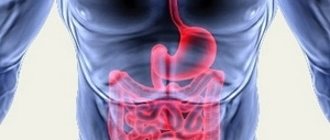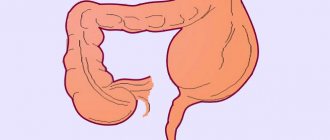- Constipation in women who are breastfeeding
- Recommendations for nursing mothers
- Mild laxative for constipation Duphalac®
During pregnancy, many women complain of constipation. This is primarily due to hormonal changes in the body. In addition, the enlarging uterus puts pressure on the intestines. As a result, blood circulation in the pelvic region is disrupted, and the susceptibility of the intestinal muscles to substances that stimulate its contractions is reduced, so that too active peristalsis does not provoke contractions of the uterus. As a rule, after childbirth, the functioning of the digestive tract normalizes, but not for everyone and not immediately.
Causes of constipation after maternity hospital
The content of the article
There are several reasons for the development of constipation in women after discharge from the hospital. Predisposing factors that cause a woman to have problems with bowel movements include:
- Hormonal changes in the body.
- Enlarged uterus.
- Decreased muscle tone in the abdominal area.
- Returning the intestines to the “right” place.
- Decreased motor activity of the intestinal tract.
- Wrong diet.
- Emotional overstrain due to stress.
- Congenital anomalies.
After the birth of a child, the mother’s body undergoes hormonal changes - the production of hCG (human chorionic gonadotropin), placental lactogen and free estriol stops. The elasticity of the muscles of the perineum and abdominal cavity is not restored immediately.
In the first weeks after childbirth, the uterus continues to put pressure on the intestines. The size of the organ is restored 7-8 weeks after birth. The baby being formed in the womb moves the intestines, so it takes some time for the CT scan to move back. This affects peristalsis and the rate of transit of feces.
A woman develops stool retention if she has had a caesarean section. She is unable to have a bowel movement because she fears the stitches will burst. Also, defecation disorders occur against the background of stress that a woman experiences during the postpartum period. Overeating and dehydration are considered causes of constipation.
Severe constipation after childbirth can torment a woman for a long time - it occurs due to congenital anomalies, which include intestinal elongation. Pathology before birth does not always make itself felt.
Causes
Why is the number of women who suffer from difficult bowel movements after childbirth so high?
Let's look at the main reasons:
- The abdominal and perineal muscles are damaged and have temporarily lost their strength and elasticity.
- The internal organs, including the intestines, have not yet had time to return to their natural position in the abdominal cavity.
- Slow peristalsis of the digestive system due to hormonal changes in a woman’s body.
- Taking analgesics – some types of anesthesia can disrupt natural processes in the body and cause constipation.
- An unbalanced diet that includes too little fluid intake.
- The appearance of hemorrhoids is a frequent companion in a woman’s postpartum life.
- The young mother's fear of damaging the stitches or increasing body pain.
- Postpartum stress and experiences.
Severe constipation after childbirth
Severe constipation after childbirth occurs if a woman has not visited the toilet for 4-6 days. Digested food forms a rough lump in the intestines, which can damage the mucous membrane and cause bleeding.
The pathology is accompanied by cutting pain in the CT area. Partial defecation is accompanied by strong straining, and there is blood in the stool. It is extremely difficult to get rid of the problem at home; in this case, going to a medical facility is mandatory.
What should a newborn's stool look like?
Proper stool for a healthy baby has a mushy consistency. The color of the stool is brown, yellowish, and sometimes has a mustard color. The smell should not be too strong, and when exposed to air, the stool will take on a greenish color. If a child is fed formula, the stool becomes more formed, in the form of a thick puree, and the frequency of bowel movements decreases.
The baby's diet stipulates that with exclusive breastfeeding, bowel movements occur from 1 to 8 times a day, after 6 months - 1-3 times in 24 hours.
What to do at home
Traditional medicine helps with postpartum constipation. In order to decide on the choice of laxative recipe, it is necessary to determine the type of pathology: for spastic and atonic constipation, different ingredients are used on the basis of which the remedy is prepared.
Plant materials that are useful for the spastic type can harm a woman with the atonic form.
Stool retention caused by spastic constipation is treated with figs and potatoes:
- 30 g of figs are brewed with boiling water (250 ml). You can use boiled milk. The container with the infusion (preferably a thermos) is hermetically sealed. The product is taken warm, 15 ml (1 tablespoon) after each meal.
- Potato tubers (2-3 pieces) are peeled and crushed in a blender. The pulp is squeezed through gauze. The resulting juice must be mixed with water (1:1). Drink 25 ml (5 tsp) three times a day after meals.
Infusions that normalize stool in atopic form:
- The fruits of cumin, anise and fennel, taken in equal parts, are mixed with medicinal preparations (leaves, stems) of the same plants (10 g each) in one container. Pour boiling water (250 – 300 ml). Allow the product to cool. Strain the warm infusion, take 30 ml half an hour before each meal.
- Rowan and fennel berries, leaves of stinging nettle, blackberry and oregano, taken in equal parts (1 tablespoon each), mix thoroughly in one container. Pour 30 g of the prepared collection with boiling water (250 ml). The product must be infused in a thermos for at least 90 minutes. Take 30 ml on an empty stomach before meals.
For severe constipation lasting 4-5 days, take a decoction of flaxseeds. 100 g of flax seeds are placed in an enamel container, pour 250 ml of hot water. The product is brought to a boil and left for 2-3 hours. Consume after dinner, once - no more than 200 ml.
The use of plant materials is possible if the woman has no contraindications.
Diet
In order for constipation to disappear from your life and not appear again, it is important to monitor your diet.
Experts recommend temporarily excluding from the menu:
- semolina and rice porridge;
- White bread;
- legumes;
- hard cheeses;
- egg white (you can leave the yolk);
- pureed dishes (soups, cereals, smoothies);
- pears;
- currants;
- chocolate;
- strong black tea.
They can be replaced with products such as:
- oatmeal, buckwheat and pearl barley porridge;
- black or bran bread;
- dairy products;
- greenery;
- vegetables, especially zucchini, cabbage, pumpkin, broccoli, carrots;
- cherry, sweet cherry, apple, apricot, peach;
- olive oil.
It is important to drink enough water. If a woman does not have kidney or heart problems, she should drink at least 2 liters of water per day.
Remedies for constipation after childbirth
Medicines can eliminate constipation after childbirth as quickly as possible. The use of medications for stool retention is carried out according to an individually selected scheme.
There are 3 types of laxatives that are relatively safe for women after childbirth who are breastfed. They do not pass into breast milk and the mother's systemic bloodstream, so they do not harm the newborn.
The therapeutic therapy aimed at normalizing intestinal motility includes the following drugs:
- candles;
- enemas and microenemas;
- Duphalac.
Long-term use of laxatives for constipation after childbirth can be addictive. Between courses it is necessary to take breaks of 7-10 days.
Literature:
- T.N. Sokur, N.V. Dubrovina. Constipation during the postpartum period. Consilium Medicum. 2012; 6:60-63
- Response of pregnancy related functional constipation to acupressure in postpartum women. Marwa Abd-El Rahman, Azza Barmoud Nashed, Mona Mohamed Taha and Amir A. Gabr Physical Therapy and Rehabilitation 2022, Volume 5, Article 11 doi: 10.7243/2055-2386-5-11
- E.Yu. Lebedeva, R.Ya. Tatarintseva. The main causes and help for postpartum constipation. Modern scientific research and innovation. 2013. No. 3. https://web.snauka.ru/issues/2013/03/22599
- N.A. Krasnova. Treatment of constipation during pregnancy and the postpartum period. Obstetrics and Gynecology, 2011, No. 7-1.
- Clinical recommendations Constipation in adults (as a manifestation of systemic diseases) Scientific Society of Gastroenterologists of Russia (NOGR) Russian Scientific Medical Society of Therapists (RNSOT). 2019
- V.V. Zubkov. Peculiarities of a woman's nutrition during pregnancy and while feeding a child. Medical Council, 2022, No. 13, pp. 86-93.
- Polushkina E.S., Grigoryan I.E. Functional constipation in pregnant and postpartum women. Medical advice. 2021;(3):77–80. doi: 10.21518/2079-701X-2021-3-77-80.
- Turawa, Eunice & Musekiwa, Alfred & Rohwer, Anke. (2014). Interventions for treating postpartum constipation. The Cochrane database of systematic reviews. 9. CD010273. 10.1002/14651858.CD010273.pub2.
- Barabash N.A., Stankevich S.S., Melnikova U.V. B240. Drug therapy during lactation: methodological. recommendations. Tomsk: Kursiv Publishing House, 2012
- Instructions for use of MICROLAX® microenemas. // Reg. number P N011146/01 // GRLS of the Russian Federation. – URL: https://grls.rosminzdrav.ru/Grls_View_v2.aspx?routingGuid=f052fb31-5426-4bc1-958f-9fce793aa43f&t= (date accessed 07/27/2021).
- Constipation in children. / Edited by S.V. Belmera, A.Yu. Razumovsky, A.I. Khavkin, R.A. Faizullina. – M.: Publishing House “MEDPRACTIKA-M”, 2016, 312 p.
Candles
For constipation after childbirth, suppositories with glycerin or sea buckthorn oil are used. Rectal suppositories soften stool and prevent the formation of plugs. Glycerin, acting as the main element, has laxative properties and accelerates the healing of microcracks around the anus. Suppositories with sea buckthorn oil are used for stool retention accompanied by the formation of hemorrhoids.
Suppositories can be used for constipation after a caesarean section, while the stitches are still healing. The insertion of rods into the anus is carried out while lying on your side. Suppositories are placed in a cool place 5-7 minutes before intended use. Before and after the procedure, hands must be disinfected.
No more than 1 candle is placed per day. Suppositories for constipation after childbirth are used for 7-10 days. In case of relapse, treatment is repeated after the prescribed time.
Types of constipation
A woman who has given birth may experience one of 3 types of constipation:
- Physiological.
It appears when feces travel too long and harden in the process.
- Spastic.
Most often it occurs due to stress and excessive tension. The intestinal muscles contract, its tone increases, and peristalsis slows down.
- Atonic.
In this case, muscle tone, on the contrary, decreases. This phenomenon usually occurs after a caesarean section. Another factor that causes atonic constipation is a woman’s poor diet.
Photo by Andrea Piacquadio from Pexels
Enema and microenemas
An enema for constipation is given to a woman who has given birth as a last resort. The cleansing procedure is not recommended for those whose stitches have not yet healed. During the postpartum period, the following types of enemas are used:
- salt;
- oil;
- cleansing.
The first 2 procedures are carried out using a bulb enema. The volume of liquid required for rinsing does not exceed 100 ml. Auxiliary components are salt and oil. The action of a salt enema lasts 30 minutes, and an oil enema lasts up to 10 hours, so it is done before bedtime.
A cleansing enema is done using an Esmarch mug - a rubber reservoir with a capacity of up to 2 liters. Apart from warm water, no additional elements are required to cleanse the intestines. The first urge to defecate is observed after 25-30 minutes.
Microenemas are considered a safer and faster alternative to conventional enemas. The laxative solution is sold in small 5 ml bottles equipped with a tip. The medicine begins to act after 15 minutes. Microclysters Microlax can be used both before childbirth and for postpartum constipation.
Prevention
To prevent constipation, we recommend paying attention to the following:
- Drink a lot.
In addition to water, a nursing woman can drink compotes, fruit drinks, herbal and berry infusions, and juices diluted with water. You should refrain from strong tea, sweet carbonated drinks and energy drinks.
- Move.
It is clear that a young mother cannot and should not engage in intense physical activity. But already in the first month after the birth of the baby, she can easily walk with him in the park or along the streets, and do light exercises.
- Watch your diet.
We talked about this in detail above. Let us remember here that nutrition should be complete and varied. Don’t forget that now you are responsible not only for your own well-being, but also for the health of your baby.
- Cure hemorrhoids.
To do this, it is important to maintain hygiene: wash with warm water after each trip to the toilet “in a big way”, and then apply ice to the area with the knots. It is good to use candles - for example, with sea buckthorn oil. Watch your body position during bowel movements: your knees should be at the same level as your stomach. If this does not happen, you can use a small stand or stool to help.
- Analyze your medications and dietary supplements.
Perhaps among them there are those that cause constipation. Most often, in cases of pregnant women, these are iron-containing preparations (maltofer, sorbifer, etc.). Consult your doctor and replace them with safer ones for your health.
Remember, the recovery period after the birth of a baby is an important stage in a woman’s life. Your world is changing rapidly, and it can often be difficult to find time for yourself. But it is necessary. Your child needs a healthy and happy mother. Take care of yourself and enjoy the unforgettable period of your child’s infancy!
Duphalac
Duphalac is available in the form of an emulsion for oral administration. The medicine has a sweet taste and plum aroma. It is completely safe for health, no side effects are observed even with long-term use. The dosage form contains lactulose - 667 mg/100 ml.
The principle of action of Duphalac for constipation after childbirth is to stimulate the peristalsis of the large intestine. At the same time, the volume of digested food increases, and the density of feces decreases.
What should be considered constipation in an infant?
Constipation is considered to be retention of stool for 2–3 days. If the baby experiences difficulty during bowel movements for 14 days or more, this is a criterion for a chronic form of the pathology. The frequency of bowel movements decreases, the feces become too hard, dense, and also have an unpleasant odor.
Constipation in a newborn baby is manifested by the following symptoms:
- the child strains too hard and for a long time during bowel movements;
- the baby’s face turns red, the legs are pressed tightly to the stomach;
- defecation causes severe pain, the baby cries;
- a red streak of blood appears on the surface of the stool (this means that the rectal mucosa was injured during defecation);
- the general condition of the child is disturbed: bloating and pain are observed;
- Parents note a decrease in the baby's appetite and increased irritability.
The symptoms of the disease are quite obvious: at the slightest concern, parents are advised to contact their pediatrician for a detailed consultation.
What not to do?
To help your baby’s body cope with constipation, you need to contact a pediatrician who will give specific recommendations for getting rid of the disease.
For example, you cannot feed a child by the hour - you need to give him food on demand, which stimulates intestinal function and the release of milk from the mother. It is also not recommended to specifically feed the baby after regurgitation, because the baby eliminated air from the stomach by regurgitation.
The use of folk remedies to stimulate defecation is prohibited: this can lead to burns or damage to the mucous membrane.
Finally, you should not use medications without a doctor’s prescription: it is unknown how they may affect the child.
Recommended Products
What a nursing mother should eat for constipation can be chosen from the list of recommended foods:
- Cereals
. Wheat, oatmeal, corn, buckwheat porridge, whole grain bread, wholemeal or bran bread. - Meat products.
All varieties of lean meat boiled, baked or stewed, soups in weak broths. - Vegetables
. Table beets, pumpkin, zucchini, cucumbers, cabbage, potatoes, tomatoes in the form of salads from fresh or boiled vegetables, side dishes, independent dishes (soups, stews, casseroles, etc.). - Dried fruits
. Dried apricots and prunes are the best foods with a laxative effect, but their consumption should be limited to 3-5 pieces. per day, as they can cause diarrhea if consumed in excess.
Up to contents
Not recommended products
The presence in the diet of foods with a laxative effect and rich in fiber is not the only condition that a diet requires for constipation in infants. It is equally important to exclude from the maternal menu products that produce a fixing effect. These include rice, semolina, pasta, baked goods, sweets, pears, pomegranates, strong brewed tea, coffee, cocoa, chocolate.
If constipation in a baby is accompanied by intestinal colic and increased gas formation, all legumes should also be excluded from the diet, and vegetables and fruits from the recommended list should be consumed only in processed form (soups, purees, stews, etc.). Laxative products during breastfeeding should also be limited if the child has unstable stools - alternating constipation and diarrhea.
Up to contents
Approved medications
Celery juice - for constipation
For prolonged constipation, accompanied by unpleasant symptoms, medications may be prescribed for symptomatic treatment. The combination of safe drug therapy with a therapeutic diet demonstrates the greatest effectiveness.
Main drugs:
- Dietary supplements based on soluble fiber.
- Stimulators of intestinal motility.
- Osmotic laxatives that improve fluid conduction.
- Stool softeners.
Most often, women are prescribed Lavacol, Forlax, Duphalac and other safe medications. Self-prescription is not recommended due to possible side effects, so consultation with a gastroenterologist is required.
It is important to remember that overuse of laxatives can cause other digestive disorders. These medications should be taken in a limited course and only for severe constipation.
Gentle nutrition for colic and constipation
As an advertisement
Proper functioning of the baby's tummy means peace and joy for the whole family. How to take care of the comfort and health of your tummy from the first days?
Every mother knows that young children experience colic, constipation and regurgitation.
First of all, these symptoms are associated with the immaturity of the digestive system, which leads to disruption of the processes of digestion and movement of food through the gastrointestinal tract (GIT). These conditions vary in severity, but despite their natural nature, they require the supervision of a pediatrician.
“Currently, functional disorders of the gastrointestinal tract occur in 70% of children in the first year of life,” - Irina Nikolaevna Kholodova, Doctor of Medical Sciences, Professor of the Department of Pediatrics named after G. N. Speransky.
“What to do if the baby is constipated?”, “How to help with colic?”, “What is the reason for regurgitation?” – these and other questions can best be answered by a doctor after an in-person examination of the child. At the appointment, pathological conditions are excluded and, according to the National Program for Optimizing Feeding of Children in the First Year of Life, diet therapy is prescribed.
Diet therapy options
If the child eats only breast milk, the mother is given recommendations on changing her diet. For bottle-fed and mixed-fed children, the prevention and treatment of colic and constipation is carried out using the correct choice of milk formula.
Selecting an adapted mixture “against colic and constipation”
1. One of the key factors influencing the absorption of the mixture is the structure of the proteins. The closer they are to the proteins of breast milk, the less often the introduction of the mixture causes digestive problems.
Formulas based on goat's milk are a good way to prevent colic, constipation and regurgitation in bottle-fed babies. In them, as in breast milk, A2 protein and alpha-lactalbumin predominate and the indigestible allergenic alpha-s1-casein is practically absent.
This gentle milk base ensures the mixtures are well tolerated, easy to digest, and helps prevent functional disorders of the gastrointestinal tract.
2. You should also pay attention to the presence of prebiotics in infant formula. These are dietary fibers that normalize intestinal motility and promote the growth of bifidobacteria and lactobacilli.
3. It is especially effective if, in addition to prebiotics, the mixture also contains probiotics (beneficial bifidobacteria B. Lactis) . They enhance each other's effects, the combination of pre- and probiotics is especially useful for restoring the balance of microflora and maintaining intestinal health.
4. Another important factor for the prevention of colic and constipation is the absence of palm oil . Replacing it with milk fat in infant formula creates favorable conditions for the formation of soft stools in the child.
Why MAMAKO® Premium
The new generation MAMAKO® Premium formulas (for children from 0 to 6 months) based on natural goat milk contain a unique set of components for comfortable digestion of the baby:
• Prebiotics.
• Probiotics (bifidobacteria B. Lactis).
• Milk lipids.
Adapted MAMAKO® Premium formulas help the baby grow and develop harmoniously, protect his digestive system from colic, constipation and regurgitation, and help prevent the occurrence of deficiency conditions (such as insufficient weight gain, anemia and rickets).
MAMAKO® Premium is a new generation of mixtures based on natural goat milk. The composition provides digestive comfort and contains an IQ complex with lutein for brain and vision development.
As shown by studies1 conducted at the Department of Pediatrics named after. G.N. Speransky, already a month after the start of feeding with MAMAKO® formula, the incidence of colic in children decreases by 3 times.
We have conquered colic! “The adapted MAMAKO® Premium mixture helped us forget about bloating, gas and colic! As a mother, it is very important to me that the baby receives everything he needs for development, grows healthy and smart! That’s why we chose MAMAKO® Premium.” Savely and his mother Kanstantsiya Koryagina, @kanstansiya
MAMAKO® complementary foods – growing healthy together!
In addition to basic nutrition, MAMAKO® took care of complementary foods to carefully protect the tummy and smooth transition to the common table. The baby's dairy menu consists of porridges, cream soups based on natural goat milk and puree with goat curd.
Porridges (for children from 5 months) and MAMAKO® cream soups (for children from 8 months) have a delicate creamy taste and are very popular with children. 32% natural goat milk in each MAMAKO® porridge and cream soup improves absorption and increases the nutritional value of the product.
Our porridge has been found! “We started our acquaintance with MAMAKO® with buckwheat porridge made with goat milk. Surprisingly, Nika eats it not only well, but even reaches for the spoon and opens her mouth! I’m happy, our porridge has been found!” Nicole and her mother Yulia Isakova, @mommyekb
MAMAKO® fruit and cottage cheese puree (for complementary feeding of children from 6 months) will help introduce cottage cheese into the baby’s diet. MAMAKO® puree contains: 20% baby goat curd and 80% selected natural fruits, no sugar or thickeners. Children's goat curd is easily and comfortably digested, and is a source of calcium, phosphorus and essential amino acids, important for the growth of the baby.
Gentle nutrition MAMAKO® with goat milk is the basis for the health of the baby’s digestive system from early childhood.
Related products: [product](MAMAKO)
Before use, you should consult a specialist.
1. I. N. Kholodova, T. A. Titova, L. R. Kudayarova, G. A. Kulakova, V. V. Nechaeva, T. G. Fetisova, M. A. Zheltukhina. Formulas based on goat's milk: is it possible to use them in the nutrition of children in the first months of life? Practical medicine. 2022, No. 10 (111), P.35-43










